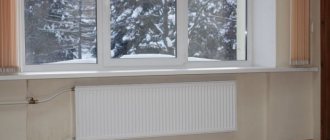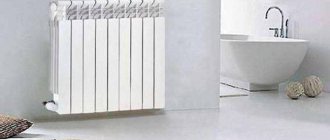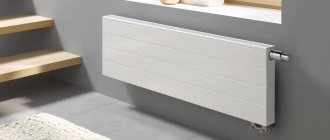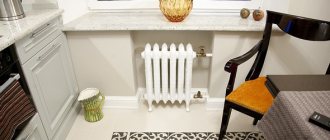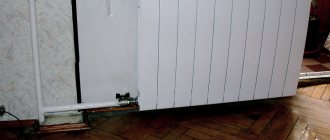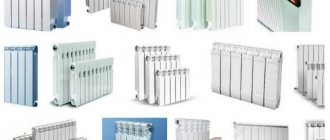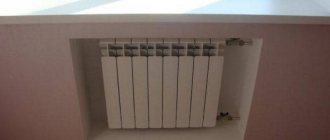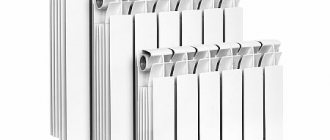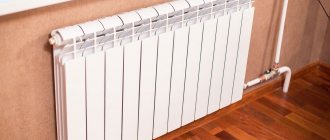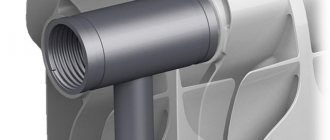Using this calculator, you can calculate heating radiators and find out the number of sections for comfortable heating of the specified area. To perform the calculation, enter the cubic capacity of the room, the heat transfer of one radiator section according to the passport (or see the table below), indicate the type of connection and the heating rate per 1 m3 of room (approximately for brick houses - 37 W/m3, for panel houses - 41 W/m3 ). When calculating through the heat losses of the room, you must use a heat loss calculator in advance. It is recommended to leave the power reserve in the region of 10-15%, since SNiP does not contain a detailed description of the calculation methodology.
Related regulatory documents:
- SP 50.13330.2010 “Thermal protection of buildings”
- SP 60.13330.2012 “Heating, ventilation and air conditioning”
- SNiP 2.04.07-86* “Heat networks”
- GOST 30494-2011 “Residential and public buildings. Indoor microclimate parameters"
- GOST 22270-76 “Equipment for air conditioning, ventilation and heating”
- GOST 31311-2005 “Heating devices”
Standard calculation of heating radiators
According to building codes and other rules, it is necessary to expend 100 W of the power of your radiator per 1 square meter of living space.
In this case, the necessary calculations are made using the formula: K - the power of one section of your radiator battery, as stated in its characteristics;
C is the area of the room. It is equal to the product of the length of the room and its width.
For example, a room is 4 meters long and 3.5 meters wide. In this case, its area is: 4 * 3.5 = 14 square meters.
The power of one battery section you have chosen is declared by the manufacturer to be 160 W. We get:
14*100/160=8.75. the resulting figure must be rounded and it turns out that such a room will require 9 sections of a heating radiator. If this is a corner room, then 9 * 1.2 = 10.8, rounded to 11. And if your heating system is not efficient enough. then once again add 20 percent of the original number: 9*20/100=1.8 rounded to 2.
Total: 11+2=13. For a corner room with an area of 14 square meters, if the heating system operates with short-term interruptions, you will need to purchase 13 battery sections.
How to use an online calculator
Online calculator for calculating the power of radiators
Calculate how many sections of heating radiators per square meter. You will need a meter, you can use special calculators that will calculate everything in the blink of an eye. Such programs can be found on the official websites of some manufacturers. These calculators are easy to use. Just enter all the relevant data into the fields and you will instantly receive the exact result. To calculate how many sections of heating radiators are needed per square meter, you need to enter data (power, temperature, etc.) for each room separately. If the rooms are not separated by doors, add up their overall dimensions, and the heat will spread throughout both rooms.
Heating calculator interface.
To avoid inaccuracies in calculations, carefully enter all parameters and check how accurate the data you provided in the appropriate fields is. It is better to double-check several times than to later suffer the consequences of your mistakes in the form of too low or high temperature in the house.
Calculation by volume
If you make such calculations, you will need to refer to the standards established in SNiP. They take into account not only the performance of the radiator, but also what material the building is built from.
For example, for a brick house the norm for 1 m2 will be 34 W, and for panel buildings - 41 W. To calculate the number of battery sections based on the volume of the room, you should: multiply the volume of the room by the heat consumption standards and divide by the heat output of 1 section.
- To calculate the volume of a room with an area of 16 m2, you need to multiply this figure by the height of the ceilings, for example, 3 m (16x3 = 43 m3).
- Heat standard for a brick building = 34 W, to find out how much is required for a given room, 48 m3 x 34 W (for a 41 W panel house) = 1632 W.
- We determine how many sections are required with a radiator power, for example, 140 W. For this, 1632 W/ 140 W = 11.66.
Rounding this figure, we get the result that a room with a volume of 48 m3 requires an aluminum radiator of 12 sections.
How to take into account effective power
Effective and design power are not the same thing. Even if the calculations are done correctly, the heat transfer may be lower. This happens due to weak temperature pressure. The required power declared by the manufacturer is usually indicated for a temperature difference of 60°C, but in reality it is often 30-50°C. This occurs due to the low temperature of the coolant in the circuit. To determine the effective power of a battery, it is necessary to multiply its heat transfer by the temperature difference in the system, and then divide by the nameplate value.
Temperature pressure is determined by the formula T=1/2×(Tn+Tk)-Tvn, where
- Tn – supply coolant temperature;
- Тк – coolant temperature at the outlet;
- Tvn – room temperature.
The manufacturer takes 90°C as Тn; for Tk – 70°C, for Tvn – 20°C. Actual values may differ greatly from the original ones. In case of extremely low temperatures, it is necessary to add 10-15% power.
It is recommended to provide the ability to manually or automatically adjust the coolant supply to each radiator. This will allow you to regulate the temperature in all rooms without wasting excess heat energy.
Accurate calculations with many parameters
It is difficult to make such calculations. The above formulas are valid for a normal room in central Russia. The geographic location of the house and a number of other factors will introduce additional correction factors.
- The final formula for a corner room should have an additional factor of 1.3.
- If the house is not located in the middle zone of the country, the additional coefficient is described by the building codes of this territory.
- It is necessary to take into account the installation location of the bimetallic radiator and decorative elements. For example, a niche under a window will take 7%, and a screen up to 25% of the thermal power of the battery.
- What will the room be used for?
- Wall material and thickness.
- How much do frames and glass cost?
- Door and window openings introduce additional problems. Let's look at them in more detail.
Walls with windows, street and doorways, change the standard formula. It is necessary to multiply the resulting number of sections by the heat transfer coefficient of the room, but it must first be calculated.
This indicator will be the sum of the heat transfer of the window, doorway and wall. All this information can be obtained by contacting SNiP, according to your type of premises.
https://youtube.com/watch?v=nSewFwPhHhM
Additional conditions taken into account in calculations
There are a large number of additional indicators that are taken into account when making calculations. We have already discussed some of them above, and we will consider others, which imply additional conditions, below. These include the following:
- If the room is equipped with a balcony, 20% is added to the result obtained.
- If there are two window openings in the room, the result increases by 30%.
- High-quality and well-installed double-glazed windows reduce the value by 10-15%.
- If you plan to install a grille or some kind of decor, the figure increases by 10-15%.
- To obtain some power reserve, which may be useful when the temperature of the region drops below average, a certain reserve is provided. Accordingly, the obtained value must be increased by 15%.
- The coolant does not always have the temperature specified by the standard. Sometimes it is 10-15 degrees cooler. Therefore, the radiator power must be increased by 18-23%.
Bimetallic radiator with diagonal connection
As you already understand, calculating the required number of radiators is quite a responsible and serious issue that requires a serious approach. Based on this, it is recommended to make an accurate calculation taking into account all of the above components and some correction factors.
Rooms with standard ceiling heights
The number of heating radiator sections for a typical house is calculated based on the area of the rooms. The area of a room in a typical house is calculated by multiplying the length of the room by its width. To heat 1 square meter, 100 W of heating device power is required, and to calculate the total power, you need to multiply the resulting area by 100 W. The resulting value means the total power of the heating device. The documentation for the radiator usually indicates the thermal power of one section. To determine the number of sections, you need to divide the total power by this value and round the result up.
A room with a width of 3.5 meters and a length of 4 meters, with a normal ceiling height. The power of one radiator section is 160 W. You need to find the number of sections.
- We determine the area of the room by multiplying its length by its width: 3.5·4 = 14 m2.
- We find the total power of heating devices 14·100 = 1400 W.
- Find the number of sections: 1400/160 = 8.75. We round up to a higher value and get 9 sections.
You can also use the table:
Table for calculating the number of radiators per M2
For rooms located at the end of the building, the estimated number of radiators must be increased by 20%.
Rooms with a ceiling height of more than 3 meters
The number of heating sections for rooms with a ceiling height of more than three meters is calculated based on the volume of the room. Volume is the area multiplied by the height of the ceilings. To heat 1 cubic meter of room, 40 W of thermal power of the heating device is required, and its total power is calculated by multiplying the volume of the room by 40 W. To determine the number of sections, this value must be divided by the capacity of one section according to the passport.
A room with a width of 3.5 meters and a length of 4 meters, with a ceiling height of 3.5 m. The power of one radiator section is 160 W. It is necessary to find the number of sections of heating radiators.
- Find the area of the room by multiplying its length by its width: 3.5·4 = 14 m2.
- We find the volume of the room by multiplying the area by the height of the ceilings: 14·3.5 = 49 m3.
- We find the total power of the heating radiator: 49·40 = 1960 W.
- Find the number of sections: 1960/160 = 12.25. Round up and get 13 sections.
You can also use the table:
As in the previous case, for a corner room this figure must be multiplied by 1.2. It is also necessary to increase the number of sections if the room has one of the following factors:
- Located in a panel or poorly insulated house;
- Located on the first or last floor;
- Has more than one window;
- Located next to unheated rooms.
In this case, the resulting value must be multiplied by a factor of 1.1 for each factor.
Corner room with a width of 3.5 meters and a length of 4 meters, with a ceiling height of 3.5 m. Located in a panel house, on the first floor, it has two windows. The power of one radiator section is 160 W. It is necessary to find the number of sections of heating radiators.
- Find the area of the room by multiplying its length by its width: 3.5·4 = 14 m2.
- We find the volume of the room by multiplying the area by the height of the ceilings: 14·3.5 = 49 m3.
- We find the total power of the heating radiator: 49·40 = 1960 W.
- Find the number of sections: 1960/160 = 12.25. Round up and get 13 sections.
- We multiply the resulting amount by the coefficients:
Corner room - coefficient 1.2;
Panel house – coefficient 1.1;
Two windows - coefficient 1.1;
First floor - coefficient 1.1.
Thus, we get: 13·1.2·1.1·1.1·1.1 = 20.76 sections. We round them up to a larger integer - 21 sections of heating radiators.
When making calculations, it should be borne in mind that different types of heating radiators have different thermal output. When choosing the number of heating radiator sections, you must use exactly the values that correspond to the selected type of battery.
In order for the heat transfer from radiators to be maximum, it is necessary to install them in accordance with the manufacturer’s recommendations, observing all the distances specified in the passport. This promotes better distribution of convective flows and reduces heat loss.
- Diesel heating boiler consumption
- Bimetallic heating radiators
- How to calculate heat for heating a house
- Calculation of reinforcement for the foundation
Technical characteristics of cast iron radiators
The technical parameters of cast iron batteries are related to their reliability and endurance. The main characteristics of a cast iron radiator, like any heating device, are heat transfer and power. As a rule, manufacturers indicate the power of cast iron heating radiators for one section. The number of sections may vary. As a rule, from 3 to 6. But sometimes it can reach 12. The required number of sections is calculated separately for each apartment.
The number of sections depends on a number of factors:
- room area;
- room height;
- number of windows;
- floor;
- presence of installed double-glazed windows;
- corner placement of the apartment.
The price given for cast iron heating radiators is per section, and may vary depending on the manufacturer. The heat dissipation of batteries depends on what material they are made of. In this regard, cast iron is inferior to aluminum and steel.
Other technical parameters include:
- maximum operating pressure – 9-12 bar;
- maximum coolant temperature – 150 degrees;
- one section holds about 1.4 liters of water;
- the weight of one section is approximately 6 kg;
- section width 9.8 cm.
Such batteries should be installed with a distance between the radiator and the wall of 2 to 5 cm. The installation height above the floor should be at least 10 cm. If there are several windows in the room, the batteries should be installed under each window. If the apartment is corner, then it is recommended to insulate the walls externally or increase the number of sections.
It should be noted that cast iron batteries are often sold unpainted. In this regard, after purchase, they must be coated with a heat-resistant decorative composition and must first be stretched.
Among domestic radiators, one can distinguish the ms 140 model. For cast iron heating radiators ms 140, the technical specifications are given below:
- heat transfer of the MS section 140 – 175 W;
- height – 59 cm;
- The radiator weighs 7 kg;
- capacity of one section - 1.4 l;
- section depth is 14 cm;
- section power reaches 160 W;
- section width is 9.3 cm;
- the maximum coolant temperature is 130 degrees;
- maximum operating pressure – 9 bar;
- the radiator has a sectional design;
- crimping pressure is 15 bar;
- the volume of water in one section is 1.35 liters;
- Heat-resistant rubber is used as a material for intersection gaskets.
It is worth noting that MS 140 cast iron radiators are reliable and durable. And the price is quite affordable. Which determines their demand in the domestic market.
Features of choosing cast iron radiators
To choose which cast iron heating radiators are best suited for your conditions, you need to take into account the following technical parameters:
- heat dissipation Select based on the size of the room;
- radiator weight;
- power;
- dimensions: width, height, depth.
To calculate the thermal power of a cast iron battery, you need to be guided by the following rule: for a room with 1 outer wall and 1 window, you need 1 kW of power per 10 sq.m. room area; for a room with 2 external walls and 1 window - 1.2 kW; for heating a room with 2 external walls and 2 windows - 1.3 kW.
If you decide to buy cast iron heating radiators, you should consider the following nuances:
- if the ceiling is higher than 3 m, the required power will increase proportionally;
- if the room has double-glazed windows, then the battery power can be reduced by 15%;
- If there are several windows in the apartment, then a radiator must be installed under each of them.
Modern market
Imported batteries have a perfectly smooth surface, they are of higher quality and look more aesthetically pleasing. True, their cost is high.
Among domestic analogues, we can highlight cast iron radiators Konner, which are in good demand today. They are characterized by a long service life, reliability, and fit perfectly into a modern interior. Konner heating cast iron radiators are available in any configuration.
- How to fill water into an open and closed heating system?
- Popular floor-standing gas boiler made in Russia
- How to properly bleed air from a heating radiator?
- Expansion tank for closed heating: device and principle of operation
- Gas double-circuit wall-mounted boiler Navien: error codes for malfunctions
Recommended reading
2016–2017 — Leading heating portal. All rights reserved and protected by law
Copying site materials is prohibited. Any copyright infringement will result in legal liability. Contacts
How to calculate heat losses for a private house and apartment
Heat escapes through windows, doors, ceilings, external walls, and ventilation systems. For each heat loss, its own coefficient is calculated, which is used in calculating the required power of the heating system.
Coefficients (Q) are determined by the formulas:
- S – area of a window, door or other structure,
- ΔT – temperature difference between inside and outside on cold days,
- v – layer thickness,
- λ – thermal conductivity of the material.
All received Q are added up, summed up with 10-40% of thermal losses through ventilation shafts. The amount is divided by the total area of the house or apartment and added to the estimated power of the heating system.
When calculating the area of walls, the sizes of windows, doors, etc. are subtracted from them. they are accounted for separately. The greatest heat loss is in rooms on the upper floors with unheated attics and basement levels with a regular basement.
The orientation of the walls plays a major role in standard calculations. The greatest amount of heat is lost by rooms facing the north and northeast (Q = 0.1). The corresponding additives are also taken into account in the described formula.
Battery types and features
Before calculating the number of batteries or sections of heating radiators per square meter based on the area of a certain room in a private house or apartment, make sure that the selection of the device was correct and that it is really suitable in your case. Let's look at their types briefly.
Aluminum
Aluminum radiators can be made from primary or secondary raw materials. The latter are noticeably inferior in quality, but are cheaper. Main advantages of aluminum batteries:
- High heat transfer,
- Light weight
- Simple universal design,
- Resistance to high pressures,
- Low inertia (quickly heat up and cool down, which allows you to quickly regulate the room temperature),
- Reasonable price (300-500 rubles per section).
Aluminum is sensitive to alkalis in the coolant, so the core is often coated with a layer of polymers, which increases the service life of the product. The main part of the models is made by casting; extrusion (extruded) sections are much less represented. Popular manufacturers. Sira, Global, Rifar and Thermal.
Bimetallic
Inside bimetallic radiators there is a steel or copper pipe, which is hidden behind an aluminum casing. Due to this, the radiator copes with high operating pressures and is less exposed to abrasive or alkaline impurities in the coolant. but at the same time retains high power, heat transfer and low inertia.
During installation it does not require additional supports. You can install it yourself.
The main disadvantage of cast iron products is their heavy weight, which complicates installation in a typical city apartment. Among the advantages:
- Large flow area, so the battery continues to work well even in the presence of deposits,
- Keeps warm for a long time
- Service life – 20-50 years,
- Stable operation at a pressure of 8-10 atm,
- Attractive retro design of cast iron sections.
According to the type of design, radiators can be sectional or panel. plate or tubular. Sectional ones are most in demand, because They are protected against water hammer and can be easily disassembled for repairs or equipped with additional elements. They are environmentally friendly and provide good heat transfer and convection.
General recommendations for calculations and requirements
To perform calculations you need to know certain parameters
- Dimensions of the room to be heated;
- Type of battery, material of its manufacture;
- The power of each section or one-piece battery, depending on its type;
- The maximum permissible number of sections of the selected radiator model;
Based on the material they are made of, radiators are divided as follows:
- Steel. These radiators have thin walls and a very elegant design, but they are not popular due to numerous shortcomings. These include low heat capacity, rapid heating and cooling. When hydraulic shocks occur, leaks often occur at the joints, and cheap models quickly rust and do not last long. Usually they are solid, not divided into sections, the power of steel batteries is indicated in the passport.
- Cast iron radiators are familiar to every person since childhood; this is a traditional material from which long-lasting batteries with excellent technical characteristics are made. Each section of the Soviet-era cast iron accordion produced a heat output of 160 W. This is a prefabricated structure, the number of sections in it is unlimited. There can be both modern and vintage designs. Cast iron retains heat well, is not subject to corrosion or abrasive wear, and is compatible with any coolant.
- Aluminum batteries are lightweight, modern, have high heat transfer, and due to their advantages they are becoming increasingly popular among buyers. The heat output of one section reaches 200 W, and they are also produced in one-piece structures. One of the disadvantages is oxygen corrosion, but this problem is solved using anodic oxidation of the metal.
- Bimetallic radiators consist of internal collectors and an external heat exchanger. The inner part is made of steel, and the outer part is made of aluminum. High heat transfer rates, up to 200 W, are combined with excellent wear resistance. The relative disadvantage of these batteries is their high price compared to other types.
Radiator materials differ in their characteristics, which affects calculations
Calculation of aluminum radiator sections per square meter
As a rule, manufacturers pre-calculate the power standards for aluminum batteries. which depend on parameters such as ceiling height and room area. It is believed that heating 1 m2 of a room with a ceiling up to 3 m in height will require a thermal power of 100 W.
These figures are approximate, since the calculation of aluminum heating radiators by area in this case does not provide for possible heat loss in the room or higher or lower ceilings. These are generally accepted building standards that manufacturers indicate in the technical data sheets of their products.
The parameter of the thermal power of one radiator fin is of considerable importance. For an aluminum heater it is 180-190 W.
The temperature of the media must also be taken into account
It can be found out from the heating management office if the heating is centralized, or it can be measured independently in an autonomous system. For aluminum batteries the figure is 100-130 degrees. Dividing the temperature by the thermal power of the radiator, it turns out that 0.55 sections are required to heat 1 m2.
In the event that the ceiling height has “outgrown” classical standards, then it is necessary to apply a special coefficient: if the ceiling is 3 m, then the parameters are multiplied by 1.05; at a height of 3.5 m it is 1.1; with an indicator of 4 m - this is 1.15; wall height 4.5 m – coefficient is 1.2.
You can use the table that manufacturers provide for their products.
How many sections of aluminum radiator are needed?
The number of sections of an aluminum radiator is calculated according to a form suitable for heaters of any type:
- S – area of the room where the battery installation is required;
- k – adjustment factor of 100 W/m2 depending on the ceiling height;
- P – power of one radiator element.
When calculating the number of sections of aluminum heating radiators, it turns out that in a room with an area of 20 m2 with a ceiling height of 2.7 m, an aluminum radiator with a power of one section of 0.138 kW will require 14 sections.
Q = 20 x 100 / 0.138 = 14.49
In this example, the coefficient is not applied, since the ceiling height is less than 3 m
But even such sections of aluminum heating radiators will not be correct, since the possible heat loss of the room is not taken into account. It should be borne in mind that depending on how many windows there are in the room, whether it is corner and whether it has a balcony: all this indicates the number of sources of heat loss
When calculating aluminum radiators by room area, the formula should take into account the percentage of heat loss depending on where they will be installed:
- if they are fixed under the window sill, then the losses will be up to 4%;
- installation in a niche instantly increases this figure to 7%;
- if an aluminum radiator is covered with a screen on one side for beauty, then the losses will amount to 7-8%;
- completely covered with a screen, it will lose up to 25%, which makes it, in principle, unprofitable.
These are not all the indicators that should be taken into account when installing aluminum batteries.
External design features
Cast iron radiators are produced only in factory conditions; mostly gray cast iron is used for these purposes. The radiator is made up of separate sections or “teeth”, each containing a round or oval shaped channel through which the coolant will move. Sections can be single-channel or double-channel. Next, the sections are assembled into a single battery, they are joined together, and heat-resistant gaskets are laid for tightness. The size of the battery will depend on the number of sections.
The size of heating radiators made of cast iron can be different; various models with different section parameters are now produced. The size is selected individually depending on the area of the room, insulation and the number of window and door openings in the house. The size of radiators can vary from 50 to 140 centimeters in depth, from 35 to 150 centimeters in height, the width is chosen based on the number of sections.
Batteries are manufactured using the casting method. Therefore, the design is sealed and reliable. Cast iron perfectly accumulates and releases heat, suitable for autonomous and centralized heating systems. Cast iron batteries have a high wear resistance and service life. They withstand pressure surges well; the operating pressure in the battery is nine atmospheres. They are also not picky about the coolant; fine sand and scale when hot water moves cannot cause significant damage to the channels inside the sections. For central heating systems, where the coolant “acquires” a good supply of chemical elements during its journey, cast iron is also suitable, since the metal does not react and does not rust.
Calculation of the number of sections of heating radiators, analysis of 3 different approaches, examples
Correct calculation of heating radiators is a rather important task for every homeowner. If an insufficient number of sections is used, the room will not warm up during the winter cold, and the purchase and operation of too large radiators will entail unreasonably high heating costs. Therefore, when replacing an old heating system or installing a new one, you need to know how to calculate heating radiators. For standard premises, you can use the simplest calculations, but sometimes it becomes necessary to take into account various nuances in order to obtain the most accurate result.
Coolant for cast iron radiators
One of the significant advantages of cast iron models is their insensitivity to various coolants. There is no need to monitor the acidity levels of the circulating fluid. The width of the channel makes it possible to freely pass through and not allow impurities to accumulate inside, of which there are a huge number in central heating systems.
Cast iron radiators do not enter into chemical reactions with antifreeze, water or other liquids containing anti-freezing additives. However, this does not mean that you can forget about water treatment. Indeed, in addition to the batteries, the coolant flows through pipe lines, inside the boiler and other installed equipment.
Thermal power of 1 section
As a rule, manufacturers indicate average heat transfer rates in the technical characteristics of heaters. So for heaters made of aluminum it is 1.9-2.0 m2. To calculate how many sections are required, you need to divide the area of the room by this coefficient.
For example, for the same room with an area of 16 m2, 8 sections will be required, since 16/2 = 8.
These calculations are approximate and cannot be used without taking into account heat loss and the actual conditions for placing the battery, since you can get a cold room after installing the structure.
To get the most accurate indicators, you will have to calculate the amount of heat that is needed to heat a specific living space. To do this, you will have to take into account many correction factors. This approach is especially important when calculating aluminum heating radiators for a private home is required.
The formula needed for this is as follows:
KT = 100W/m2 x S x K1 x K2 x K3 x K4 x K5 x K6 x K7
- KT is the amount of heat that a given room requires.
- S – area.
- K1 – designation of the coefficient for a glazed window. For standard double glazing it is 1.27, for double glazing it is 1.0, and for triple glazing it is 0.85.
- K2 is the coefficient of the wall insulation level. For a non-insulated panel it = 1.27, for a brick wall with one layer of masonry = 1.0, and for two bricks = 0.85.
- K3 is the ratio of the area occupied by the window and the floor. When between them:
- 50% - coefficient is 1.2;
- 40% — 1.1;
- 30% — 1.0;
- 20% — 0.9;
- 10% — 0.8.
- K4 is a coefficient that takes into account the air temperature according to SNiP on the coldest days of the year:
- +35 = 1.5;
- +25 = 1.2;
- +20 = 1.1;
- +15 = 0.9;
- +10 = 0.7.
- K5 indicates adjustment in the presence of external walls. For example:
- when she is alone, the indicator is 1.1;
- two external walls – 1.2;
- 3 walls – 1.3;
- all four walls – 1.4.
- K6 takes into account the presence of a room above the room for which calculations are made. If available:
- unheated attic - coefficient 1.0;
- heated attic – 0.9;
- living room – 0.8.
- K7 is a coefficient that indicates the height of the ceiling in the room:
- 2.5 m = 1.0;
- 3.0 m = 1.05;
- 3.5 m = 1.1;
- 4.0 m = 1.15;
- 4.5 m = 1.2.
If you apply this formula, you can foresee and take into account almost all the nuances that may affect the heating of the living space. Having made a calculation using it, you can be sure that the result obtained indicates the optimal number of aluminum radiator sections for a particular room.
If you decide to install aluminum radiators, it is important to know the following:
Whatever principle of calculation is undertaken, it is important to do it as a whole, since correctly selected batteries allow you not only to enjoy warmth, but also significantly save on energy costs. The latter is especially important in the context of constantly rising tariffs
Heat transfer of one section
Today there is a wide range of radiators. While most are similar in appearance, thermal performance may differ significantly. They depend on the material from which they are made, on the dimensions, wall thickness, internal cross-section and on how well the design is thought out.
Therefore, it is possible to say exactly how many kW in 1 section of an aluminum (cast-iron bimetallic) radiator only in relation to each model. This data is provided by the manufacturer. After all, there is a significant difference in size: some of them are tall and narrow, others are low and deep. The power of a section of the same height from the same manufacturer, but of different models, may differ by 15-25 W (see the table below STYLE 500 and STYLE PLUS 500). There may be even more noticeable differences between different manufacturers.
Technical characteristics of some bimetallic radiators
Please note that the thermal power of sections of the same height may have a noticeable difference. However, for a preliminary assessment of how many battery sections are needed for space heating, we calculated the average thermal power values for each type of radiator
They can be used for approximate calculations (data are given for batteries with an interaxial distance of 50 cm):
However, for a preliminary assessment of how many battery sections are needed for space heating, average thermal power values were calculated for each type of radiator. They can be used for approximate calculations (data are given for batteries with an interaxial distance of 50 cm):
- Bimetallic - one section produces 185 W (0.185 kW).
- Aluminum - 190 W (0.19 kW).
- Cast iron - 120 W (0.120 kW).
More precisely, how many kW can you have in one section of a bimetallic, aluminum or cast iron radiator when you choose a model and decide on the dimensions. The difference in cast iron batteries can be very big. They are available with thin or thick walls, which causes their thermal output to change significantly. Above are the average values for batteries of the usual shape (accordion) and those close to it. Retro-style radiators have significantly lower thermal output.
These are the technical characteristics of cast iron radiators from the Turkish company Demir Dokum. The difference is more than significant. She could be even bigger
Based on these values and average standards in SNiP, the average number of radiator sections per 1 m2 was calculated:
- the bimetallic section will heat 1.8 m2;
- aluminum - 1.9-2.0 m2;
- cast iron - 1.4-1.5 m2;
How to calculate the number of radiator sections using this data? It's still simpler. If you know the area of the room, divide it by the coefficient. For example, a room of 16 m2, to heat it you will need approximately:
- bimetallic 16 m2 / 1.8 m2 = 8.88 pcs, rounded - 9 pcs.
- aluminum 16 m2 / 2 m2 = 8 pcs.
- cast iron 16 m2 / 1.4 m2 = 11.4 pcs, rounded up - 12 pcs.
These calculations are only approximate. Using them, you can roughly estimate the costs of purchasing heating appliances. You can accurately calculate the number of radiators per room by choosing a model, and then recalculating the number depending on the temperature of the coolant in your system.
Methods for assessing heat transfer
Before purchasing heating batteries, we will consider ways to calculate the number of their elements.
The first method is based on the area of the room. Construction standards (SNiP) state that for normal heating 1 sq. m. requires 100 W. thermal power. By measuring the length and width of the room, and multiplying these two values, we get the area of the room (S).
To calculate the total power (Q), we substitute our value into the formula, Q=S*100 W. The passport for heating radiators indicates the heat transfer of one element (q1). Thanks to this information, we will know the required number. To do this, divide Q by q1.
The second method is more accurate. It should also be used with a ceiling height of 3 meters or more. Its difference lies in measuring the volume of the room. The area of the room is already known, let's measure the height of the ceiling, then multiply these values. We substitute the resulting volume value (V) into the formula Q=V*41 W.
According to building codes, 1 cubic meter. m. should be heated by 41 W. thermal power. Now let's find the ratio of Q to q1, obtaining the total number of radiator nodes.
Let's sum up the interim results and bring out the data that will be needed for all types of calculations.
- Wall length;
- Wall width;
- Ceiling height;
- Power standards for heating a unit of area or volume of a room. They are given above;
- Minimum heat transfer of the radiator element. It must be indicated in the passport;
- Wall thickness;
- Number of window openings.
Specified and actual heat transfer of the radiator
The parameters of any heating device are indicated in the technical passport.
Typically, manufacturers declare the power of 1 standard section with an interaxle size of 500 mm within the range of 170...200 watts. The characteristics of aluminum and bimetallic radiators are approximately the same. The trick is that the heat transfer rating cannot be stupidly used to select the number of sections. According to clause 3.5 of GOST 31311-2005, the manufacturer is required to indicate the battery power under the following operating conditions:
- the coolant moves through the radiator from top to bottom (diagonal or side connection);
- temperature difference is 70 degrees;
- the flow rate of water flowing through the device is 360 kg/hour.
Let’s explain the essence of the problem; to do this, substitute the known values of ΔT = 70 °C and room temperature – plus 20 °C into the formula, and perform the reverse calculation:
- tsupply + treturn = (ΔT + tair) x 2 = (70 + 20) x 2 = 180 °C.
- According to the standards, the calculated difference in coolant temperatures between the supply and return lines should be 20 degrees. This means that the water coming from the boiler needs to be heated to 100 °C, the return water will cool to 80 °C.
- The 100/80 °C operating mode is not available for domestic heating installations; the maximum heating is 80 degrees. In addition, maintaining the specified coolant temperature is not economically profitable (remember, we took the average value of 65 °C).
Conclusion. In real conditions, the battery will give off much less heat than specified in the operating instructions. The reason is the lower value of ΔT - the temperature difference between water and ambient air. According to our initial data, the ΔT indicator is 130 / 2 - 22 = 43 degrees, almost half the declared norm.
Standard calculation of heating radiators
According to building codes and other rules, it is necessary to expend 100 W of the power of your radiator per 1 square meter of living space. In this case, the necessary calculations are made using the formula:
K is the power of one section of your radiator battery, as stated in its characteristics;
C is the area of the room. It is equal to the product of the length of the room and its width.
For example, a room is 4 meters long and 3.5 meters wide. In this case, its area is: 4 * 3.5 = 14 square meters.
The power of one battery section you have chosen is declared by the manufacturer to be 160 W. We get:
14*100/160=8.75. the resulting figure must be rounded and it turns out that such a room will require 9 sections of a heating radiator. If this is a corner room, then 9 * 1.2 = 10.8, rounded to 11. And if your heating system is not efficient enough. then once again add 20 percent of the original number: 9*20/100=1.8 rounded to 2.
Total: 11+2=13. For a corner room with an area of 14 square meters, if the heating system operates with short-term interruptions, you will need to purchase 13 battery sections.
Finally, a few clarifications
Heating devices can operate in different conditions and be connected according to different schemes. These factors influence the heat transfer of heaters during operation. When determining the power of room radiators, consider several recommendations:
- If the battery is connected to the pipelines using a different bottom circuit, the heating efficiency deteriorates. Add 10% to the calculated power rating of the devices.
- In combined systems (radiator network + warm water floors), convection devices play a supporting role. The main heating load is carried by floor circuits. But the calculated heat transfer of radiators should not be underestimated; if necessary, the batteries should completely replace heated floors.
- Homeowners often cover heaters with decorative screens, even covering them with drywall, leaving convection gaps. In this case, the infrared heat generated by the heated surface of the device is completely lost. Accordingly, the battery power will have to be increased by at least 40%.
- Do not install 1-3 radiator sections, even if the calculation shows this amount. To get a normal heating device, you need to install at least 4 fins.
- Non-freezing liquids are inferior to ordinary water in terms of heat capacity, the difference is approximately 15%. When using antifreeze, increase the heat transfer area of the batteries by 10% (increase the number of radiator sections or panel sizes).
When calculating heating radiators, consider a simple rule: the lower the water temperature in the supply line, the larger the heat exchange surface area needed to heat the rooms. Select boiler equipment correctly and install systems so that you do not have to solve problems by expanding battery sections.
Calculation example
If you calculate how many sections of an aluminum radiator are needed for a room with an area of 20 m2 at a rate of 100 W/m2, then adjustment coefficients for heat loss should also be made:
- each window adds 0.2 kW to the indicator;
- the door “costs” 0.1 kW.
If it is assumed that the radiator will be placed under the window sill, then the correction factor will be 1.04, and the formula itself will look like this:
Q = (20 x 100 + 0.2 + 0.1) x 1.3 x 1.04 / 72 = 37.56
- the first indicator is the area of the room;
- the second is the standard number of W per m2;
- the third and fourth indicate that the room has one window and one door;
- the next indicator is the heat transfer level of the aluminum radiator in kW;
- the sixth is a correction factor regarding the location of the battery.
Everything should be divided by the heat output of one heater fin. It can be determined from the table from the manufacturer, which shows the heating coefficients of the carrier in relation to the power of the device. The average for one edge is 180 W, and the adjustment is 0.4. Thus, multiplying these numbers, it turns out that one section produces 72 W when heating water to +60 degrees.
Since rounding is done upward, the maximum number of sections in an aluminum radiator specifically for this room will be 38 fins. To improve the performance of the structure, it should be divided into 2 parts of 19 ribs each.
Find out useful information about aluminum batteries on our website:
Comparative findings
The heat transfer of aluminum radiators is slightly lower, although they are lighter and cheaper than bimetallic ones. In terms of test and operating pressure, aluminum devices can also be installed in buildings of any number of floors, but subject to: the presence of an individual boiler room with a water treatment unit. The fact is that aluminum alloy is susceptible to electrochemical corrosion from low-quality coolant inherent in central networks. It is better to install aluminum radiators in separate systems.
Cast iron radiators differ sharply from others. the heat transfer of which is significantly lower with a large mass and capacity of the sections. It would seem that with such a comparison they would not find application in modern heating systems. Nevertheless, the traditional MS-140 “accordion” continues to be in demand, their main trump card is durability and resistance to corrosion. Indeed, gray cast iron, from which MS-140 is made by casting, can easily serve for up to 50 years or more, and the coolant can be anything.
In addition, a conventional cast iron battery has high thermal inertia due to its massiveness and capacity. This means that when the boiler is turned off, the radiator remains warm for a long time. As for the operating pressure, cast iron heaters cannot boast of high strength. Purchasing them for networks with high water pressure is risky.
Calculations of the number of sections by quadrature per room
The accuracy of the calculations depends on the number of factors taken into account. In general, they can be divided into three groups:
- The calculation by area is based on the assumption that at least 100 W are needed to heat each square meter. That is, for a room of 10 m2 you need a radiator with a power of 1 kW (about 7 sections). The figures are relevant for rooms with ceilings up to 2.6 m.
- An accurate calculation involves taking into account the coefficients for all heat losses. The required number of sections for installing a heating radiator is calculated using the following calculation formula - multiplying 100 (watt/m2) by the area of the room in m2 and by each coefficient (q).
The determination by volume gives approximately the same figures as the formula for calculating by area. According to SNIP recommendations, the heat consumption in the living room of a panel house with wooden windows is 41 W per cubic meter. If there are modern double-glazed windows, the standard is reduced to 34 W per 1 m3. Heat consumption is reduced for buildings with wide walls made of foam concrete, brick, etc., as well as in the presence of high-quality thermal insulation.
How to calculate the number of sections and estimated power of heating radiators? The simplest formulas:
N = S x 100 / P (excluding heat loss)
N = V x 41 W x 1.2 / P (including heat loss)
- N – number of sections,
- P – power of one radiator section,
- S – room area,
- V – room volume 41 W – heating power 1 m3,
- 1.2 – standard heat loss coefficient.
The heat transfer of the section for each specific model is indicated by the manufacturer on the edge of the product. On average the indicators are:
Metal at the base of the section
Average section heat transfer rate
To simplify all calculations, some specialized resources offer online calculators, where you just need to enter the initial data and get the finished result in a second. Read how to independently calculate the number of sections of bimetallic heating radiators here.
Preliminary preparation
What needs to be taken into account to calculate the power of a heating radiator per room:
- determine the temperature regime and potential thermal losses;
- develop optimal technical solutions;
- determine the type of thermal equipment;
- establish financial and thermal criteria;
- take into account the reliability and technical parameters of heating devices;
- draw up heat distribution diagrams and the location of batteries for each room;
Without the help of specialists and additional programs, it is quite difficult to calculate the number of sections of heating radiators. To make the calculation as accurate as possible, you cannot do without a thermal imager or programs specially installed for this.
Required power of heating radiators
What happens if the calculations are done incorrectly? The main consequence is a lower temperature in the premises, and therefore operating conditions will not correspond to the desired ones. Heating appliances that are too powerful will lead to excessive spending on both the appliances themselves and their installation, as well as on utilities.
Useful tips for properly arranging your heating system
Bimetallic radiators come from the factory connected in 10 sections.
After calculations, we got 10, but we decided to add 2 more in reserve. So, it's better not to do it. Factory assembly is much more reliable and comes with a warranty of 5 to 20 years. Assembly of 12 sections will be carried out by the store, and the warranty will be less than a year. If the radiator leaks soon after this period ends, repairs will have to be carried out on your own. The result is unnecessary problems.
Let's talk about the effective power of the radiator. The characteristics of the bimetallic section indicated in the product passport are based on the fact that the temperature pressure of the system is 60 degrees.
This pressure is guaranteed if the temperature of the coolant in the battery is 90 degrees, which does not always correspond to reality. This must be taken into account when calculating the room radiator system.
Below are some tips for installing the battery:
- The distance from the window sill to the top edge of the radiator should be at least 5 cm. Air masses can circulate normally and transfer heat to the entire room.
- The radiator needs to lag behind the wall by a length of 2 to 5 cm. If reflective thermal insulation is attached behind the battery, then you need to purchase extended brackets that provide the specified gap.
- The bottom edge of the battery is supposed to have a distance of 10 cm from the floor. Failure to follow the recommendation will worsen heat transfer.
- A radiator mounted against a wall, and not in a niche under a window, must have a gap of at least 20 cm with it. This will prevent the accumulation of dust behind it and help heat the room.
It is very important to make such calculations correctly. This determines how efficient and economical the resulting heating system will be.
All the information given in the article is aimed at helping the average person with these calculations.
Bimetallic radiators: features
Bimetallic heating batteries are becoming increasingly popular today. This is a worthy replacement for the hopelessly outdated “cast iron”. The prefix “bi” means “two”, i.e. In the manufacture of radiators, two metals are used - steel and aluminum. They are an aluminum frame with a steel pipe inside. This combination in itself is optimal. Aluminum guarantees high thermal conductivity, and steel guarantees a long service life and the ability to easily withstand pressure drops in the heating system.
Prices for popular bimetallic heating radiators
It became possible to combine seemingly incompatible things thanks to a special production technology. Bimetallic radiators are made by spot welding or injection molding.
- long life span. High build quality and a reliable “union” of two metals turns radiators into “long-livers”. They can serve regularly for up to 50 years;
- strength. The steel core is not afraid of pressure surges characteristic of our heating systems;
- high heat transfer. Thanks to the presence of an aluminum body, the bimetallic radiator quickly heats the room. In some models this figure reaches 190 W;
- resistance to rust formation. Only steel comes into contact with the coolant, which means that the bimetallic radiator is not afraid of corrosion. This quality becomes especially valuable during seasonal cleaning and water dumping;
- pleasant appearance". The bimetallic radiator is much more attractive in appearance than its cast-iron predecessor. There is no need to hide it from prying eyes with curtains or special screens. In addition, radiators differ in color and design. You can choose what you like;
- light weight. Significantly simplifies the installation process. Now installing a battery will not require much effort and time;
- compact size. Bimetallic radiators are valued for their small size. They are quite compact and easily fit into any interior.
What to do if you need a very accurate calculation
Unfortunately, not every apartment can be considered standard. This applies even more to private residential buildings. The question arises: how to calculate the number of heating radiators, taking into account the individual conditions of their operation? To do this, you will need to take into account many different factors.
The peculiarity of this method is that when calculating the required amount of heat, a number of coefficients are used that take into account the characteristics of a particular room that can affect its ability to store or release thermal energy. The formula for calculations looks like this:
KT = 100W/sq.m. * P * K1 * K2 * K3 * K4 * K5 * K6 * K7. Where
KT - the amount of heat required for a specific room; P - room area, sq.m.; K1 - coefficient taking into account the glazing of window openings:
- for windows with conventional double glazing - 1.27;
- for windows with double glazing - 1.0;
- for windows with triple glazing - 0.85.
K2 - coefficient of thermal insulation of walls:
- low degree of thermal insulation - 1.27;
- good thermal insulation (two bricks or a layer of insulation) - 1.0;
- high degree of thermal insulation - 0.85.
K3 - ratio of window area to floor area in the room:
K4 is a coefficient that allows you to take into account the average air temperature in the coldest week of the year:
- for -35 degrees - 1.5;
- for -25 degrees - 1.3;
- for -20 degrees - 1.1;
- for -15 degrees - 0.9;
- for -10 degrees - 0.7.
K5 - adjusts the heat demand taking into account the number of external walls:
K6 - taking into account the type of room located above:
- cold attic - 1.0;
- heated attic - 0.9;
- heated living space - 0.8
K7 - coefficient taking into account the height of the ceilings:
This calculation of the number of heating radiators includes almost all the nuances and is based on a fairly accurate determination of the room’s need for thermal energy.
All that remains is to divide the obtained result by the heat transfer value of one section of the radiator and round the resulting result to a whole number.
Some manufacturers offer an easier way to get the answer. On their websites you can find a convenient calculator specifically designed to make these calculations. To use the program, you need to enter the required values in the appropriate fields, after which the exact result will be given. Or you can use special software.
When we got an apartment, we didn’t think about what kind of radiators we had and whether they suited our house. But over time, a replacement was required and they began to approach it from a scientific point of view. Since the power of the old radiators was clearly not enough. After all the calculations we came to the conclusion that 12 is enough. But you also need to take into account this point - if the TEC does not do its job well and the batteries are a little warm, then no amount will save you.
I liked the last formula for a more accurate calculation, but the coefficient K2 is not clear. How to determine the degree of thermal insulation of walls? For example, a 375mm thick wall made of GRAS foam block, is it low or medium? And if you add 100mm of dense construction foam to the outside of the wall, will it be high, or still medium?
Ok, the last formula seems to be good, windows are taken into account, but what if the room also has an external door? What if this is a garage with 3 windows 800*600 + door 205*85 + sectional garage doors 45mm thick with dimensions 3000*2400?
If you do it for yourself, I would increase the number of sections and install a regulator. And voila - we are already much less dependent on the whims of the thermal power plant.
Parameters to be taken into account when calculating
Approximate calculations are attractive due to their simplicity, but do not provide reliable information. As a result, the apartment owner may freeze, or overpay for the installation of expensive radiators.
An accurate calculation must take into account many correction parameters:
- Glazing condition;
- Number of external walls;
- Their thermal insulation;
- Thermal conditions of the upper room;
- Climatic characteristics of the region and other parameters.
Calculation by volume
If you make such calculations, you will need to refer to the standards established in SNiP. They take into account not only the performance of the radiator, but also what material the building is built from.
For example, for a brick house the norm for 1 m2 will be 34 W, and for panel buildings - 41 W. To calculate the number of battery sections based on the volume of the room, you should: multiply the volume of the room by the heat consumption standards and divide by the heat output of 1 section.
- To calculate the volume of a room with an area of 16 m2, you need to multiply this figure by the height of the ceilings, for example, 3 m (16x3 = 43 m3).
- Heat standard for a brick building = 34 W, to find out how much is required for a given room, 48 m3 x 34 W (for a 41 W panel house) = 1632 W.
- We determine how many sections are required with a radiator power, for example, 140 W. For this, 1632 W/ 140 W = 11.66.
Rounding this figure, we get the result that a room with a volume of 48 m3 requires an aluminum radiator of 12 sections.
